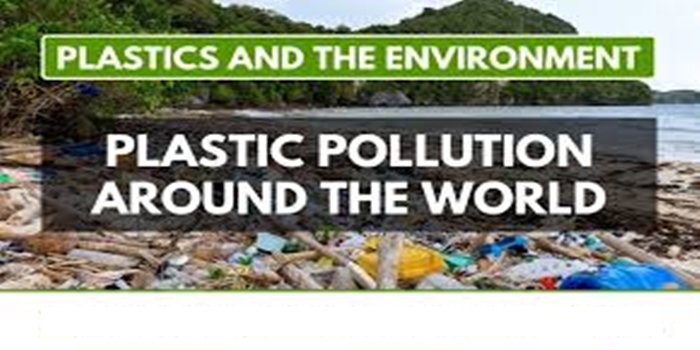In this article, we discussed the meaning of plastic pollution, the types, the causes, the effects, we also talked about the solution
Definition
Plastic pollution is the gathering of plastic in the environment, which harms wildlife, habitats, and human health. It’s a global problem that affects the environment, food security, health, and economies.
How does plastic pollution occur?
Plastic waste from land, such as packaging, single-use items, and household products, ends up in waterways and oceans
Abandoned, lost, or discarded fishing, boating, or aquaculture gear pollutes the ocean
Plastic breaks down into microplastics, which can persist in the environment for centuries
Plastic production and consumption releases emissions that harm the environment.
Types of plastic waste.
Microplastics
These are plastic pieces that are smaller than 5 millimeters and are almost invisible to the naked eye.
They are created when plastic breaks down.
Primary microplastics include nurdles and cosmetic microbeads.
Polystyrene
This plastic is not biodegradable and is difficult to recycle.
It is often found in the environment and can travel long distances on the wind or water.
Low-density polyethylene (LDPE)
This lightweight and flexible plastic is used in plastic bags, packaging films, and squeeze bottles.
It can persist in the environment for hundreds of years and can entangle marine life.
Plastic bottles
These are one of the most commonly found bits of debris floating around the ocean.
It’s estimated that plastic bottles take around 450 years to decompose.
Balloons
These can blow away, burst, deflate, and return to pollute the planet.
Animals can mistake them for food or become entangled in their ribbons.
Landfills
Plastics occupy a considerable portion of landfill space due to their volume and slow decomposition rates.
Plastic pollution is caused by the following:
Production
Excessive plastic production: The production of plastics contributes to plastic pollution
Industrial discharges: Chemical factories and other industrial activities can release plastics into the environment
Use
Overuse of single-use plastics: Single-use plastics like straws, bags, and bottles are often used and then thrown away
Plastics in agriculture: Plastics are used in agriculture and can end up in the environment
Disposal
Improper waste disposal: When plastic is thrown away in landfills or the ocean, it can harm the environment and wildlife
Incorrect recycling practices: Not separating plastics, not removing liquids, and not drying recyclables correctly can contribute to plastic pollution
Poor waste management: Inefficient waste management systems can lead to plastic pollution
Other causes
Littering: Littering contributes to plastic pollution
Tyre abrasion: Tires can wear down and release plastics into the environment
Construction: Construction activities can release plastics into the environment
Fishing: Plastic fishing nets can get ripped and end up in the ocean.
The effect of plastic pollution:
Marine life disruption:
Plastic debris can entangle and suffocate marine animals, while smaller plastic fragments (microplastics) can be ingested by a wide range of species, leading to digestive issues and potential starvation.
Chemical contamination:
Plastics can leach harmful chemicals into the environment, which can accumulate in organisms through the food chain, causing reproductive and developmental issues.
Habitat destruction:
Large plastic accumulations can alter natural habitats, disrupting ecosystem functions.
Climate change contribution:
Plastic production is derived from fossil fuels, contributing significantly to greenhouse gas emissions throughout its lifecycle.
Human health concerns:
Ingestion of microplastics through food and water, and potential exposure to plastic-associated chemicals, raise concerns about potential health impacts on humans.
Economic impacts:
Plastic pollution can harm tourism industries by spoiling beaches and affecting recreational activities.
Important points to remember about plastic pollution:
Persistence:
Plastic is a non-biodegradable material, meaning it can take hundreds of years to break down, leading to long-term environmental impacts.
Microplastics:
When plastic breaks down, it forms tiny microplastics which can easily enter the food chain and are particularly difficult to remove from the environment.
Global issue:
Plastic pollution is a widespread problem affecting all oceans and ecosystems around the world.
What can be done to address plastic pollution:
Reduce plastic use: Minimize single-use plastic items and choose reusable alternatives.
Proper waste management: Recycle and dispose of plastic waste responsibly.
Support sustainable practices: Advocate for policies that encourage the development and use of biodegradable and recycled plastic materials.
The Solution to Plastic Pollution
Individual actions:
Carry reusable items: Always bring your own reusable water bottle, shopping bags, coffee cup, and utensils to avoid single-use plastics.
Say no to single-use plastics: Refuse straws, plastic cutlery, and excessive packaging when possible.
Buy in bulk: Opt for bulk items with minimal packaging to reduce waste.
Choose eco-friendly products: Look for products with minimal plastic packaging or made from recycled materials.
Properly recycle: Understand local recycling guidelines and dispose of plastic waste correctly.
Policy and industry changes:
Legislation and bans: Support policies that restrict the production and usage of certain single-use plastics, like plastic bags.
Extended producer responsibility (EPR): Implement systems where manufacturers are responsible for managing the end-of-life of their products, encouraging sustainable design.
Investment in recycling infrastructure: Improve recycling facilities and technologies to efficiently process and reuse plastic waste.
Promote sustainable alternatives: Encourage research and development of biodegradable or compostable plastic substitutes.
Community involvement:
Beach and river cleanups: Participate in organized cleanups to remove plastic debris from the environment.
Education and awareness campaigns: Spread information about the impacts of plastic pollution and ways to reduce it.
Support eco-conscious businesses: Choose to shop from companies committed to sustainable practices and reducing plastic waste.
Conclusion
Plastic pollution refers to the accumulation of discarded plastic waste in the environment, including oceans, rivers, and land, which can harm wildlife through ingestion and entanglement, disrupt ecosystems, and potentially affect human health due to microplastics entering the food chain, all stemming from the non-biodegradable nature of plastic and improper waste management practices; this is considered a major global environmental issue.

